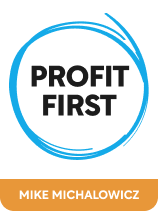

This article is an excerpt from the Shortform book guide to "Profit First" by Mike Michalowicz. Shortform has the world's best summaries and analyses of books you should be reading.
Like this article? Sign up for a free trial here .
What is the Profit First method? Why is the Profit First method better than the traditional business accounting method?
In the Profit First method, a percentage of income is set aside as profit before any expenses are calculated. This allows an entrepreneur to do their business accounting in a simple and intuitive way, and to increase their business’s profitability and stability.
Here’s an overview of the book Profit First by Mike Michalowicz.
Profit First by Mike Michalowicz
In his book Profit First, Mike Michalowicz criticizes traditional business accounting methods by claiming that they are unintuitive, and that their unintuitive nature leads many entrepreneurs to failure. He then outlines an alternate accounting system, which he calls the Profit First method.
Part 1: Defining the Profit First Method
In this section, we’ll explore the main principles of traditional accounting, Michalowicz’s argument for why they don’t work, and the main tenets of his Profit First accounting method.
Traditional Business Accounting
First, let’s clarify what Michalowicz is referring to when he talks about traditional accounting. Specifically, he’s referring to three main principles in his arguments, which he claims are the common wisdom of the business world.
- Traditional business accounting recommends starting with income, subtracting all expenses, and labeling the difference as profit.
- Constantly look to grow your business and put growth as your first priority. Growth leads to an increase in your income as well as the overall value of your company in case another company wants to buy it.
- Traditional accounting also advises that you consult financial documents like balance sheets or income statements regularly, so you know what’s going on financially in your business at all times.
The Danger of Traditional Accounting
While traditional principles work for some, they also lead many businesses to failure. Michalowicz argues that this high failure rate exists because traditional accounting principles clash with the way most people think and make decisions.
Michalowicz identifies one major clash in particular: Entrepreneurs interpret the traditional principle that growth is success to mean they should reinvest all their money—including their profits and personal funds—back into their expenses. They think that this increase in expenses will be covered by the increased income from their larger business. However, reinvestment into growth makes a business unstable, as it creates high costs and eliminates cash on hand. This instability can make slow sales periods fatal for a business.
Challenges in Addressing Instability
The instability that comes from a rapidly growing business is also very difficult for most entrepreneurs to fix, says Michalowicz. He outlines three additional ways traditional principles clash with natural decision making and explains how these clashes prevent entrepreneurs from stabilizing their businesses.
1) Many entrepreneurs become used to the extra expenses they reinvested their profits on, and don’t want to get rid of them. They might have a hard time recognizing that they don’t need the company car or office space they have grown accustomed to, for example.
2) Financial documents are often complex and difficult to navigate, even for accountants. This can make it difficult for entrepreneurs to even recognize when their business is financially unstable.
3) Financial instability and uncertainty often lead entrepreneurs to make irrational or panicked decisions, which only put a business into further trouble. Often, these decisions involve looking for increased growth and sales even if they come with expenses or opportunity costs.
Core Tenets of the Profit First Method
Now that we’ve shown how traditional accounting clashes with normal thinking and decision making, we’ll outline Michalowicz’s accounting system: the Profit First method. In this system, a percentage of income is taken as profit before any expenses are paid. The Profit First method works on four main tenets, which allow an entrepreneur to avoid the challenges of traditional accounting by using the natural way they think to make healthy financial decisions.
Tenet #1: Limit Your Resources
Michalowicz’s first tenet is to allocate a specific percentage of your income for expenses (we’ll discuss how to do this later on). By allocating only a percentage of your income to expenses, you’ll force yourself to spend that money more efficiently. That’s because of Parkinson’s Law: the theory that the more resources we have available, the more resources we will use. This theory works the other way as well: the fewer resources we have available, the fewer we’ll need to use.
Tenet #2: Order in Terms of Importance
The next tenet Michalowicz outlines is to allocate your income in order of importance, starting with profit to emphasize that it’s your first priority. This works due to what psychology calls the primacy effect: When given multiple pieces of information, our natural tendency is to better remember and place more importance on the first one given to us.
Tenet #3: Removing Temptation
For the third tenet, Michalowicz advises that you remove the temptation to reinvest money into growth by creating savings accounts for profit and other essentials, and making those accounts inconvenient to access. By making that money harder to access, you’ll be less tempted to misuse it.
Tenet #4: Keep Good Habits
Finally, Michalowicz’s fourth tenet is to make a habit of dividing your income between profit and expenses and paying your bills consistently. By making a habit of dividing income amongst your business’s bank accounts, you can recognize financial changes just by looking at their account balances. Then, you can react to those changes calmly because you’ll have seen them coming.
Part 2: Setting up the Profit First Method
Now that we understand the benefits of the Profit First system, we’ll discuss how to set it up step by step. The process involves four different steps, all of which make it easier to understand your business’s finances.
Step #1: Bank Accounting
You’ll first open new bank accounts. Michalowicz recommends organizing your accounting with seven bank accounts, so you can understand your business’s finances by checking their account balances. First, he advises you to open five checking accounts at your primary bank: an income account, a profit account, an account for your personal salary, an account for tax money, and an account for all other expenses. In addition to your checking accounts, open two savings accounts at a separate bank: one for tax money, and one for profits. Transfer money from your tax and profit checking accounts into these savings accounts regularly, and make them inconvenient to withdraw from so you aren’t tempted to misuse their money.
Step #2: Assessing Your Business’s Current Financial Health
Once you have your bank accounts set up, Michalowicz says it’s time to assess your business’s current financial health. He explains that you should find the percentage of your income you’re spending on each aspect of your business: profit, your personal salary, taxes, and expenses. Then, you can compare these to a healthy business’s percentages. The more similar they are, the healthier your business is.
Using the Allocation Percentage Equation
To assess your business’s financial health, Michalowicz first outlines how to find what percentage of your income is allocated to each aspect of your business.
- Find your total income from the last 12 months.
- Now, add up all expenses spent on materials and subcontractors, and label these costs as (M).
- Subtract your material and subcontractor costs (M) from your total income to find your adjusted revenue. Label this value as R.
- Find how much money went into the following:
- Profit: Profit from the last year that you didn’t reinvest into your business.
- Salary: Your salary from last year.
- Taxes: How much of your business’s money you used to pay for taxes last year. If you use your business’s money to pay your personal taxes, include that amount here.
- Expenses: All expenses from the last 12 months minus your costs of goods sold.
- Now, divide each of those values by your adjusted revenue to find what percentage is allocated to each.
Your Allocation Percentages Versus Healthy Allocation Percentages
Now, you can compare your percentages to Michalowicz’s in the table below for the appropriate adjusted revenue bracket. The closer your percentages are to those in the table, the healthier your business is financially.
| Adjusted Revenue Bracket (R) | A = Profit Result | A = Owner’s Compensation Result | A = Taxes Result | A = Expenses Result |
| 0 – 250k | 5% | 50% | 15% | 30% |
| 250k – 500k | 10% | 35% | 15% | 40% |
| 500k – 1m | 15% | 20% | 15% | 50% |
| 1m – 5m | 10% | 10% | 15% | 65% |
| 5m – 10m | 15% | 5% | 15% | 65% |
| 10m – 50m | 20% | 0% | 15% | 65% |
Finding Your Business’s Ideal Allocation Percentages
While the percentages Michalowicz gave in the previous section are a good general example of where a healthy business allocates its income, he also provides the following instructions for finding your own ideal allocation percentages.
1) Your ideal profit percentage: To find your business’s ideal profit percentage, look up the records of successful public companies in your industry similar to your business’s size, then divide their profit by their revenue for the past three to five years. The average of those results will give you a good idea of an ideal profit percentage.
2) Your ideal salary percentage: To determine an appropriate salary for yourself, Michalowicz recommends you pay yourself the same amount you would pay an employee to do your work. Divide this salary by last year’s adjusted revenue for your ideal salary percentage.
3) Your ideal tax percentage: Michalowicz emphasizes here that your ideal tax percentage covers your business’s taxes and your personal income taxes. Find your ideal tax percentage by adding the amount you paid last year on your business and personal taxes together, then dividing that number by your adjusted revenue from the last year.
4) Your ideal expense percentage: To calculate your ideal expense percentage, subtract your profit, salary, and tax percentages from 100%. This is the “leftover” money you’ll use for expenses.
Your First Year Using the Profit First Method
Once you’ve found your ideal percentages, Michalowicz says not to match them too quickly–if you allocate too much money away from expenses, you’ll often end up without enough money to keep your business running. Instead, gradually change how you spend your money. Michalowicz outlines three new financial habits for doing so.
1) When you change your current percentages to meet your ideal percentages, start by only changing three percent. Subtract three percent from a percentage currently higher than its ideal, and add it to a percentage currently below its ideal.
2) Allocate income to your bank accounts and pay your bills twice a month, so you can keep track of how much you spend and when you spend it.
3) Take half of the money in your profit savings account for yourself at the start of each quarter as a reward for yourself, and to leave the rest of the money in the account as an emergency fund.
Part 3: Using the Profit First Method Long-Term
Once you’ve set up the Profit First method, you can start using it long-term to improve your financial stability and profitability. To do so, Michalowicz offers detailed instructions for improving your business by cutting expenses and increasing efficiency.
Cutting Expenses
Michalowicz explains that as you increase your profit percentage, you’ll need more money available for your profit allocation. However, he emphasizes that increasing your income is not how to get this additional money, because cutting expenses is a faster and easier way to make money available. Michalowicz recommends you cut costs by compiling a list of all expenses from the last year. Then, for each expense, ask yourself, “Is this necessary for keeping my business running or making customers happy?” If the answer is no, cut that cost. If the answer is yes, then consider ways you can accomplish the same thing in a cheaper way.
Focus On What’s Profitable
In addition to cutting expenses, Michalowicz also suggests you improve your business by specializing in whatever makes the most profit. He suggests two areas to consider when looking for profitability: services and clients.
Specialization in your most profitable services reduces the time and money spent on a given sale by narrowing your focus on fewer, more consistent tasks, and only providing these profitable services means every sale you make will have a high profit margin.
Michalowicz also recommends you focus more on serving your most profitable clients—clients who consistently ask for your main product or service and aren’t difficult to work with. If you have any clients who are only interested in difficult to provide services or are difficult to work with, he says to drop those clients because they’ll reduce your profits.

———End of Preview———
Like what you just read? Read the rest of the world's best book summary and analysis of Mike Michalowicz's "Profit First" at Shortform .
Here's what you'll find in our full Profit First summary :
- Why traditional business accounting methods don't work
- How to use the Profit First method to increase your business’s profitability and stability
- How to assess your business's current financial health






